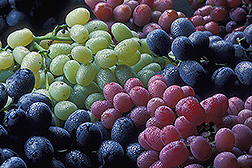|

Genetic
fingerprints, now being developed for the 2,800 wild, rare and domesticated
grapes in ARS's northern California genebank, will help grape breeders pinpoint
unusual characteristics. Click the image for more information about
it.
|
|

|
“Fingerprinting” Helps Make Great
Grapes
By Marcia
Wood August 26, 2008
At about this time next year, nearly all of the 2,800 wild, rare and
domesticated grapes in a unique northern California genebank will have had
their "genetic profile" or “fingerprint” taken. These fingerprints
may help grape breeders pinpoint plants in the collection that have unusual
traits--ones that might appeal to shoppers in tomorrow's supermarkets. Other
grapes might be ideal for scientists who are doing basic research.
That’s according to Agricultural Research Service (ARS) plant
geneticist
Mallikarjuna
Aradhya. He's heading the grape fingerprinting venture.
The grape collection that Aradhya is fingerprinting encompasses
vineyards and screened enclosures, called “screenhouses." It is part of
what’s officially known as the ARS
National
Clonal Germplasm Repository for Tree Fruit and Nut Crops and Grapes, in
Davis, Calif.
To glean a distinctive genetic fingerprint of each member of the
collection, Aradhya uses pieces of genetic material--or DNA--known as
microsatellite markers. Eight markers are all that are needed for a genetic
fingerprint of more familiar grapes, like close relatives of those already used
for making wine or raisins or for eating out-of-hand.
But the lesser-known ones--wild grapes and some prized types from
China, for instance--require twice as many markers for reliable identification.
That’s due, in part, to the fact that the taxonomy, or relatedness of one
kind of grape to another, is quite jumbled, Aradhya noted.
He has already fingerprinted 1,100 better-known grapes and 300 wild
specimens.
ARS is a scientific research agency of the
U.S. Department of
Agriculture.